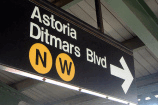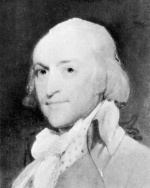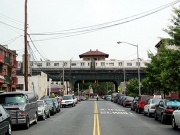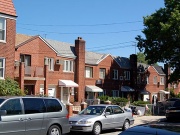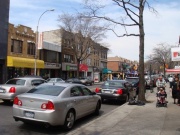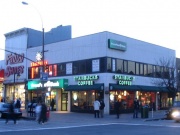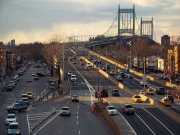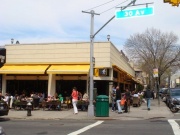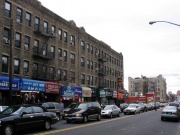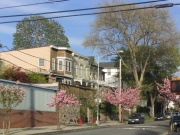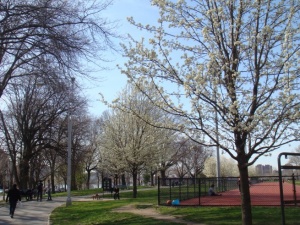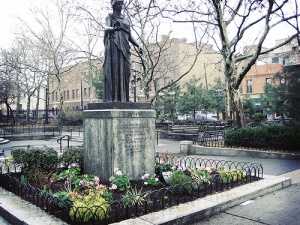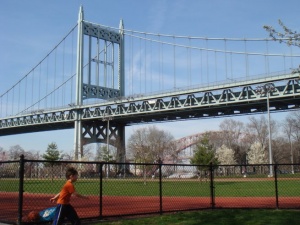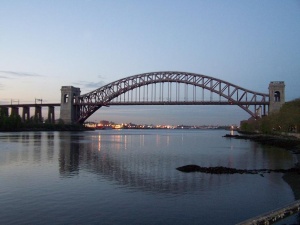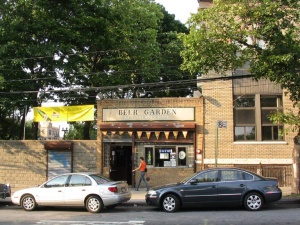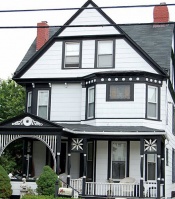| wiki | search |
Home
| Population Trends
| Gentrification
| Culinary Demography
| Architecture
Houses of Worship
| Art in Astoria
| Film Industry
| Steinway
| Index
| Contributors

Drive Through Astoria
| This video was filmed from a car driving down Ditmars Boulevard towards the Hell Gate Bridge. Ditmars is a major commercial boulevard in Astoria that contains diverse restaurants and stores. While watching the video, one may notice the transition from a dynamic business area to a tranquil residential area. In essence, Astoria truly is a microcosm of New York City. |
Location
| Astoria is known for its cosmopolitan mixture of cultures, peoples, and small businesses. It is located on the northwest corner of Queens, New York and is surrounded by the East River on its north and west sides. Bordering Long Island City, Sunnyside, and Woodside, Astoria has become a popular residential area for young professionals because of its fast commute to Manhattan, its relatively inexpensive rent, and the rich dining and nightlife it offers. |
View Astoria & Ditmars in a larger map |
History
Astoria was originally named Hallett's Coveafter the landowner William Hallett who lived there in 1659. Hallet's Cove was then renamed after John Jacob Astor in order to convince him to invest $2,000 in the place, but Astor only invested $500. Astor never visited the neighborhood that he invested in. A long fight over naming the neighborhood finally ended with the help of Astor's friends and supporters so the neighborhood was named Astoria. Astor became the wealthiest man in America by 1840 with a net worth of over $20 million.[1] He lived in his summer home called Hell Gate in Manhattan on East 87th Street where he could see the village that was named after him. [2]
During the 19th century, many wealthy New Yorkers built large houses in Astoria Village (12th and 14th Street) which is now considered Old Astoria. In 1839 Steven Halsey founded Hallet's Cove and created a ferry service from Hallet's Cove to Manhattan 92nd Street. Hallet's Cove became a leisurely place for the affluent New Yorkers to relax. [3]
In the late 1800s, there was an increase in the industrial life that brought German immigrants who were furniture and cabinet makers. The most famous settler was Henry Steinway who founded the Steinway Piano Company in 1853 and also built a sawmill, foundry, and streetcar line. The family created Steinway Village for their workers. [4]
Astoria and near villages were added to Long Island City in 1870. Long Island City was then incorporated to New York City in 1898.[5]
Geography
The N and W subway trains bring life to Astoria. The “yellow line” as many locals from Astoria have dubbed it, runs above ground from Ditmars Boulevard to Queens Borough Plaza.
Ditmars Boulevard is the first stop on the N and W trains. It is also the northern border of the Astoria. There is still a strong Greek American presence reflected in the restaurants, small businesses and schools that line the avenue.
The next stop is Astoria Boulevard. Astoria Boulevard provides the entrance to the Grand Central Parkway and the Robert F. Kennedy Bridge previously known as the Triborough Bridge. Local Astorians have three ways to commute to their jobs.
The following stop and major avenue is 30th Avenue. This is widely considered the “Heart of Astoria”. It offers an exemplary myriad of cafes, restaurants, and of course specialty and apparel stores. The avenue isn’t particularly dominated by one culture and its diversity creates a strong sense of community. Notable aspects of the avenue include the fact that every street corner has a café and it is a place “see and be seen”. On one block there is a Japanese sushi place, a Greek real estate agency, a Polish fabric store, an Irish pub, an Iranian video store, a Cyprian specialty food store, a Pakistani health foods store and a Greek hair salon. The diversity optimizes choice.
Broadway is not the last stop on the N train but it’s the last stop that is part of Astoria. It offers similar permutations of the small businesses found on 30th Avenue. Another way to get around the main avenues of Astoria is to take the bus. The Q18, Q19, Q69, Q101, Q102, Q103 and the Q104 run east and west through the parts of Astoria that the train stations do not.[6]
Important Places
Astoria Park
Astoria Park is located on the west side of Queens bordering the East River. On the strip, there is a beautiful view of the Manhattan skyscrapers as well as the Robert F. Kennedy Bridge (formerly known as the Triborough Bridge) and Hell Gate Bridge. The park has two playgrounds, six tennis courts, an athletic field, three baseball diamonds, a bocce court, a pool, gazebo, public restroom and an outdoor track. Astoria Park has New York City's largest swimming pool. It was used for the 1936 and 1964 Summer Olympics trials. The park was first created when the City of New York obtained the 56 acre of land in October 1913 and it was named William J. Gaynor Park. The name was then changed to East River Park and was officially named Astoria Park in December 1913. Astoria park was then expanded by 9.5 acres in 1969 making it officially 65.78 acre.[7]
Athens Square Park
Athens Square Park is located on 30th Avenue and 30th Street. Some people consider it the capital of modern Greece. In 1963, .9 acres were set aside to build this park and the local public school P.S. 17. The play space was used for neighborhood gatherings for Astoria’s Greek American population. Most of the Greek Americans immigrated to America during the Greek Civil War 1945-49. In acknowledgement of this connection, Mayor Demetris Avarmopoulos presented a statue of Athena, the goddess of wisdom as a gift to the city of New York in 1998.
Modern day Athens Square Park is currently under construction and three new jungle gyms for the children of P.S. 17 are being built. Concerts for local bands are regularly held in the summer. The park also holds regular dance performances that include traditional Greek line dances, Turkish belly dancing and traditional Indian dance. It is also a popular spot to relax for people of all walks of life. In the early morning, senior citizens and dog walkers relax on the benches. When the sun goes down, local skateboarders use the low steps of the plaza as their own skateboard park and amuse pedestrians with their tricks. Regardless of time however, Athens Square Park represents the strong Greek American roots and growing population of Astoria.
[8]
Robert F. Kennedy Bridge (formerly known as the Triborough Bridge)
The Robert F. Kennedy Bridge previously known as the Triborough Bridge connects Astoria to the Bronx and Manhattan with 2,780 feet of steel. It consists of three parts, The East River Suspension Bridge, The Harlem River lift Bridge, and the Bronx Kill Crossing. Incidentally the first day of construction for the bridge was black Friday in 1929. President Hoover ceased construction during the Great Depression. Then Franklin Delano Roosevelt’s New Deal money financed the construction of the bridge and Robert Moses headed the design and construction of the bridge. It is now owned and operated by the Triborough Bridge and Tunnel Authority. In modern pop culture the light blue Triborough bridge is iconic. In the popular kids video game Grand Theft Auto IV, its exact replica is featured as the “East Borough Bridge”. It may be a bridge with a toll but it provides Astorians with a fast commute the Upper East Side of Manhattan.[9]
Hell Gate Bridge
The Hell Gate Bridge is an impressive 1,017 foot steel arch bridge and an impressive feat of engineering. It connects Astoria to Randall's Island and runs close by the Robert F. Kennedy Bridge. It is also part of the New York Connecting Railroad that connects New York City to mainland America. It was also featured prominently in the 1973 narcotics and police reform film “Serpico” staring Al Pacino. During World War II the Nazis targeted the bridge as part of Operation Pastorius. In 1996 Hellsgate Bridge underwent renovation and was painted a charismatic befitting dark red. Modern day Hellsgate Bridge serves as a way for local New Yorkers to get to concerts held on Randall's Island during the summer. Commuters can also take the Amtrak rail line to cross over the bridge. The stone ledges at the base of the bridge are also popular place for local teenagers to relax despite the steep drop at the edge. Its main claim to fame is its durability. According to “Discover Magazine” it would take 1000 years to disintegrate completely. Other bridges would take about 300 years if left unattended.[10]
Bohemian Hall and Beer Garden
At one time New York contained 800 beer halls only 3 of which were in Astoria. Now the only remaining beer hall run by the Bohemian Citizens’ Benevolent Society of Astoria is in Astoria. The purposes of the Bohemian Citizens' Benevolent Society of Astoria, Inc. (hereinafter, the "Society") is to encourage, support and maintain Schools, Dramatics, Lectures and Libraries for Czech and Slovak children and children of Czech and Slovak parentage: It also serves to maintain a nonprofit social home for people of Czech and Slovak ancestry, in which the Czech and Slovak culture may be taught and blended with American traditions and culture, thereby tending to make the members better Americans. In reality, the Society owns and manages the entire facility. Member meetings are monthly and typically start at 8:00pm on the last Friday of the month. The total membership is over 200, although most do not attend meetings on a regular basis. The board publishes a periodic newsletter called the Astorian, to keep members informed of events, finances, and plans for the future.[11]
Old Astoria
Old Astoria contains some of the most beautiful antebellum and Victorian mansions built in New York. They can be found on in the aptly named “Old Astoria” section of Astoria between Astoria Boulevard and Hoyt Avenue and 12th street to 23rd Street. "I grew up in Astoria. I went to school in Astoria. My children were raised here. And they're going to take me out of this house when I'm old and gray and dead in a body bag – because I'm not selling," says Susan Koren, who has lived on 12th Street since 1944. Susan refuses to sell her Victorian mansion because of the recent condominiums and co-op apartments that are slowly encroaching an area fighting for landmark status. Larry Supon, owner of the "Tara," arguably the most beautiful mansion on 12th Street says he often gets offers of several million dollars for his home, which he has spent 25 years restoring. The people of Old Astoria have a tempting choice to make when it comes to selling their houses. The price for them however is losing the historic charm and leaving Old Astoria to a fate of hodgepodge of historic houses and bland unaesthetically pleasing buildings.[12]
Interesting Facts
- The head of the CIA, George Tenet was born in Astoria, Queens.
- Christopher Walken, a famous Hollywood actor was also born in Astoria.
- Astoria Boulevard and 31st Street is home to an increasing population of feral cats.
- An abandoned property on the corner of Astoria Boulevard and 31st Street is referred to as the "Cat House."
- The Astoria resident Chester Carlson created the first version of a Xerox Machine by photocopying the image 10-22-38 ASTORIA on his copy in a beauty parlor at 32-05 37th Street.
- The Cadillac Man is a homeless man who lives under the viaduct in Astoria, Queens and published Land of the Lost Souls: My Life on the Streets.
- 41st Street and 42nd Street were formerly known as Albert Street and Theodore Street named after Steinway’s sons.
- Local bikers drag race along the "Strip" (The street between Astoria Park and the East River) all night long during summer
References
- ↑ "John Jacob Astor." A Classification of American Wealth. 2007. Ranken. 22 Apr. 2009 <http://www.raken.com/American_wealth/encyclopedia/profile.asp?code=83>.
- ↑ " AstoriaQueens.com - Astoria Queens, An NYC Neighborhood and Community. Astoria Queens. 20 Apr. 2009 <http://astoriaqueens.com/>.
- ↑ "The History of Astoria and Long Island City." My Astoria - Early Astoria History - Astoria LIC, Queens NY. 2004. My Astoria. 20 Apr. 2009 <http://www.myastoria.com/history/>.
- ↑ "The History of Astoria and Long Island City." My Astoria - Post Industrial LIC- Astoria LIC, Queens NY. 2004. My Astoria. 20 Apr. 2009 <http://www.myastoria.com/history/>.
- ↑ Roleke, John. "Long Island City History." Long Island City History. 2009. About.Com. 20 Apr. 2009 <http://queens.about.com/od/neighborhoods/a/longislandcity_3.htm>.
- ↑ "Astoria, New York." NationMaster - Encyclopedia: Astoria, New York. 2003. Nation Master. 21 Apr. 2009 <http://www.nationmaster.com/encyclopedia/Astoria,-New-York>.
- ↑ "Astoria Park." Astoria Park-Historical Sign. 26 Mar. 2001. New York City Departments of Parks and Recreation. 22 Apr. 2009 <http://www.nycgovparks.org/sub_your_park/historical_signs/hs_historical_sign.php?id=8891>.
- ↑ "Athens Square Park." Athens Square Park-Historical Sign. 8 Mar. 2001. New York City Departments of Parks and Recreation. 22 Apr. 2009 <http://www.nycgovparks.org/sub_your_park/historical_signs/hs_historical_sign.php?id=221>.
- ↑ "Robert F. Kennedy-Triborough Bridge (I-278)." New York Area Roads, Crossings and Exits. 06 May 2009 <http://www.nycroads.com/crossings/triborough/>.
- ↑ "Hell Gate Bridge." New York Area Roads, Crossings and Exits. 06 May 2009 <http://www.nycroads.com/crossings/hell-gate/>.
- ↑ Willoughby, Ian. "Traditional Czech beer garden in Astoria drawing huge crowds from all over NYC." 19 June 2008. Radio Praha. 3 May 2009 <http://www.radio.cz/en/article/105274>.
- ↑ Brennan, Tom, and Irene Plagianos. "Tearing Down History in Old Astoria." 2007. Columbia University. 4 May 2009 <http://www.newmedianewsroom.com/student/a/brenplag_astoria/>.
Home
| Population Trends
| Gentrification
| Culinary Demography
| Architecture
Houses of Worship
| Art in Astoria
| Film Industry
| Steinway
| Index
| Contributors

